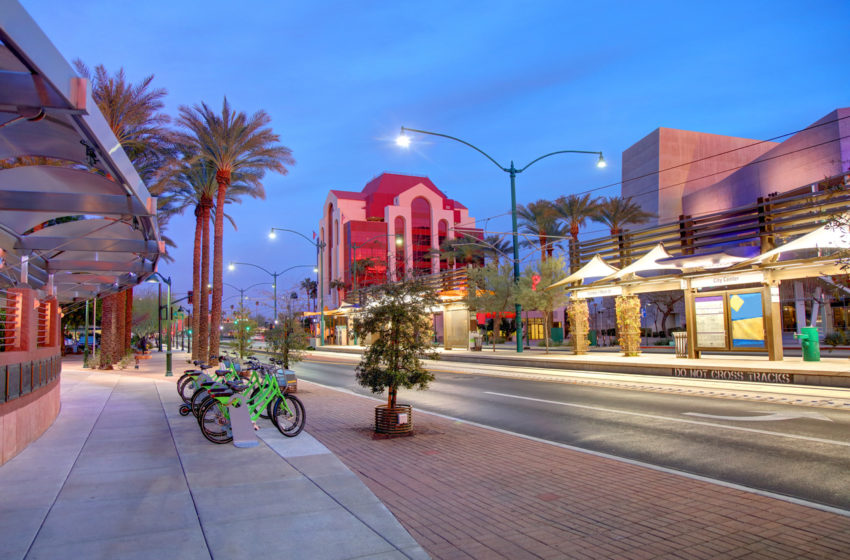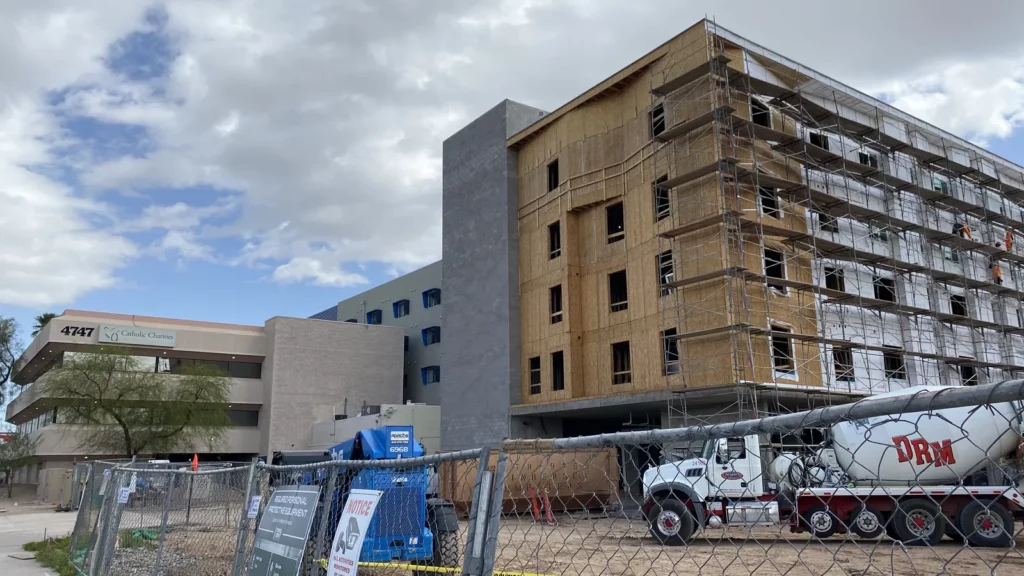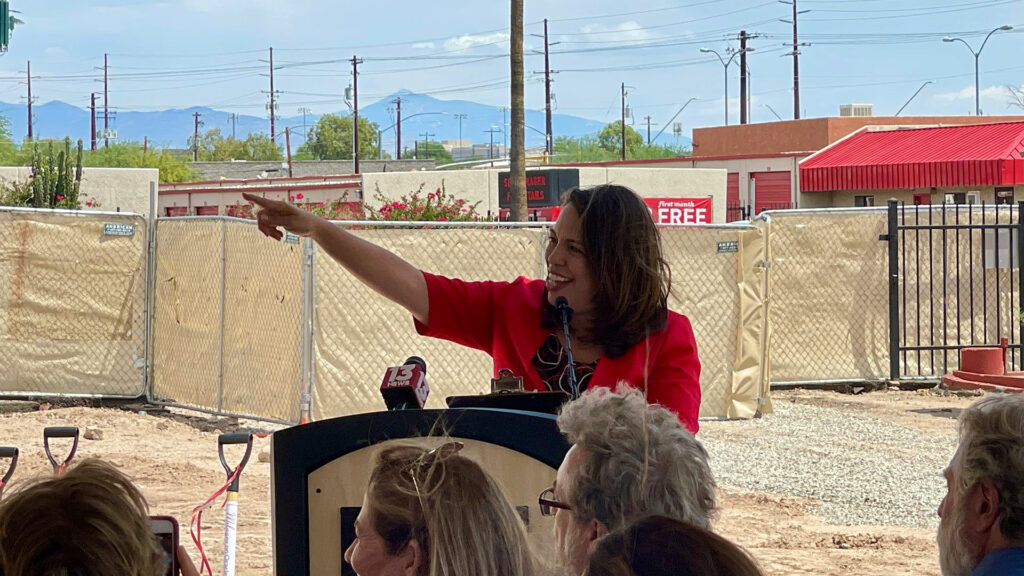Developers have a plan to revamp infamous Mesa eyesore. Will it work?

Mesa is a city in Maricopa County, in the U.S. state of Arizona. It is a suburb located about 20 miles east of Phoenix. Mesa is the largest suburban city by population in the United States
Mesa spent millions buying and bulldozing some 60 houses downtown more than 20 years ago to make way for a multimillion-dollar resort on the land.
That development never materialized, and now residents near the vacant land worry a newly proposed project could raise rents and price them out of the historically Black Washington-Escobedo Heritage Neighborhood.
Plans unveiled earlier this year call for market-rate apartments, shops, offices and a park on the land near Mesa and University drives. It even came with a new name, Nexus Mesa. As the site languished for years, leaders have joked that the property’s two most recent names, Site 17 and Transform 17, were cursed.
The proposed development is music to the ears of some city leaders and residents, who for decades have viewed the 27-acre vacant lot as an eyesore.
Others argue the project should contain at least some affordable housing units, given the city’s history of buying people out of their homes and, in one case, exercising eminent domain.
“These calls for affordable housing aren’t just reflections of policy preference or some kind of unified ideology in the region,” Washington-Escobedo resident Oscar Mancinas said. “They’re acknowledgments of the really horrendous history and the way people were mistreated on Site 17.”
Those who want to see affordable housing included in the project say it would be a step toward doing right by the people whom Mesa once bought out of this area. Affordability could potentially bring back people who had to leave decades ago, they say.
Vice Mayor Jenn Duff, who represents the area on the Mesa City Council, is pushing for the project to at least include affordable units. She said the development would ideally include a mix of affordable, workforce, market-rate and luxury rentals.
“We need to make amends,” Duff said. She said it’s high time something gets built there, but she wants to make sure it doesn’t push even more people out of the area.
Many of the residents the city bought out years ago were Hispanic. Now, many of the residents worried about being priced out of the surrounding area are Black and Hispanic.
“There needs to be a focused strategy not just to revitalize that area … but benefit the people who are there now and not just have an importing of wealth, shifting problems from one neighborhood to the next,” downtown resident Augie Gastelum said.
But some see the project as an opportunity to capitalize on the renaissance happening in downtown Mesa. There’s new life downtown, which is landing trendy restaurants, opening a massive Arizona State University film school and housing a thriving arts center.
Mayor John Giles said the city already has seen to it that the surrounding area has affordable apartment options.
Nearby neighborhood is a living piece of Black history in Arizona
The area surrounding Nexus Mesa is among the city’s most diverse. Many longtime residents nearby are Hispanic and Latino. Just north of the proposed Nexus Mesa project is a diverse, historically Black neighborhood with rich history.
In the Washington-Escobedo neighborhood across University Drive, some Black residents can recall a time when they weren’t allowed to live anywhere else in the city.
More Black Americans started moving to Mesa in the early 1900s, but they weren’t allowed to own homes in the original townsite, according to city documents. So they settled north, in what’s known today as the Washington-Escobedo Heritage Neighborhood.
Joyce Bailey, 77, was 6 months old when her family moved from Mississippi to Mesa in the 1940s.
Bailey said Arizona wasn’t as visibly discriminatory as Mississippi. There was still discrimination — it just looked different, she said.
Back then, the neighborhood was divided by dirt roads.
The city yard to the north, between her neighborhood and Fitch Park, was farmland then. There was public housing. The school for Black children was named after Booker T. Washington. Even after integration, people here had wedding receptions at the Booker T. Washington School, Bailey said.
She and her childhood friends were not allowed to swim in the city’s outdoor swimming pool. They had to stand outside the fencing. At times, in the scorching summer heat, white children would cup water in their hands and run over to splash it on them through the gaps in the fence, she recalled.
They could swim in the canals. Many in her family were baptized in those canals.
She remembers entering a drugstore downtown when she wasn’t supposed to. It had a sign saying it didn’t serve Black people, but no one stopped her. When she visited family in Mississippi, she would have been stopped before she even made it through the door, she said.
“Nobody said nothing to me, but there was a sign saying that they didn’t serve Blacks,” she said. “I never felt that in Arizona.”
Even though they faced discrimination in their own city, their neighborhood was a special refuge. Where else in the Valley, her son Todd Bailey said, could Black children be surrounded by family? Some residents remember it as something of an oasis for Black Arizonans in the mid-1900s.
Joyce Bailey remembers a time when she had a relative on every street in the Washington-Escobedo neighborhood. Now there are only a couple left.
But like many neighborhoods across Arizona, it didn’t take long for development to come in and shake things up.
People sold their land. New businesses came in. People left Arizona for opportunities elsewhere.
“I know change has to happen,” Todd Bailey said. “(But) they always choose us first.”
The neighborhood’s narrow streets still are lined with World War II-era homes, many of them built by their original owners, like Joyce Bailey’s father.
The neighborhood finds itself in the middle of a triangle of development, with Mesa’s revitalized downtown to the south and rapidly expanding suburbia to the east.
The land to the north sits separated from the neighborhood by a wall so beige the blinding Arizona sun reflects off it. Homes and agricultural fields to the north started to disappear in the 1980s as homeowners started to sell their farmland to the city. Now, much of the land houses city facilities, including the city’s transportation department, and a National Guard facility. Just beyond that is the Oakland Athletics’ training site.
Per capita income in the area’s ZIP code is less than $24,000, according to census data.
Neil Calfee, a consultant representing the Nexus Mesa developer Miravista Holdings, said developers are considering how best to pay respect to the area’s rich history.
“Part of what we’re looking to understand is what would make sense, what would do right by the community. … Maybe partnering with the (ASU) film school and doing something that’s not just a plaque. Is there something that’s more lasting in terms of oral history interviews?” he said. “We know that living history is not getting any younger.”
The pitch: 800-plus market-rate apartments, plus retail and office space
Proposed plans for the site south of the Washington-Escobedo neighborhood are not yet final and likely won’t go to a City Council vote until late August at the earliest.
Early plans call for:
- 800-850 market-rate units in a mix of styles, including townhomes and more dense apartments.
- 200,000 square feet of office space.
- A parking garage.
- 25,000 to 30,000 square feet of retail.
- A park to serve as a buffer between rental units and single-family homes that already exist to the south.
The mayor said this development could be a game-changer for the area, just like the Dobson Ranch community was further south, or Eastmark was to the east.
Residents in those sprawling communities often say they “live in Eastmark” before they say they live in Mesa, like some north Phoenicians say they “live in Anthem.” Giles believes Nexus Mesa could be like that for downtown residents.
Recently, a new housing development from The Church of Jesus Christ of Latter-day Saints’ development arm brought hundreds of new residents downtown, near the temple. For Giles, projects like this are the missing ingredient to the area’s success.
“The thing we need in downtown Mesa is people. We’ve got great amenities, hundreds of millions of dollars invested in infrastructure and arts, a character-rich downtown and ASU,” he said. “The puzzle is pretty well filled in. What we need is a bunch of people walking around on the sidewalk.”
Should it include affordable housing?
When developer Miravista Holdings pitched its vision for the property, area residents — including Duff — were quick to ask for affordable housing.
Dozens of residents and a handful of affordable housing advocates attended two public meetings in April. Many of them asked the developer to make at least part of the project affordable.
The area’s ZIP code, 85201, has the second-highest poverty rate in Mesa, with nearly one in five people living beneath the poverty line, according to U.S. Census Bureau data.
Some worry that market-rate rentals could influence rent prices in the surrounding area and price longtime residents out of their homes.
Calfee, the consultant representing Miravista Holdings, said the property has sat vacant for too long.
“People have been holding their breath, or holding off on investing in their property, until something happens out here,” he said.
Giles, who grew up near this area, said he’s proud of the way Mesa has substantially invested in affordable housing nearby, including the affordable complexes El Rancho Del Arte Apartments, La Mesita Apartments, Salvation Army Silvercrest Residence and Encore on First.
What the area needs, he said, are more options.
“It’s important that we have a diverse housing stock in Mesa, and especially downtown. We have placed emphasis on affordable housing projects along the light rail corridor,” Giles said. “My thought is: It’s not a priority to build affordable housing literally across the street from affordable housing. Escobedo is literally across the street.”
Robert Reynolds, who owns two rental units next to the dirt lot, said he hopes the project gets built as proposed.
“It’s not that I’m against affordable housing. Rather, the property was designed initially to be something that would bring in economy to the area and provide income,” he said. “With all the things that could go there, some more medium-income homes and some commercial property … seems like that would be the best investment for all of the city.”
Reynolds said he has renovated his property while the dirt lot languished. He used the money he made from his Afghanistan deployment in the U.S. Army Reserves to buy the units. “It’s not like I’m some sort of investment mogul,” he said.
He said the area needs more housing, and not just affordable housing.
“What else can you put there? Walmart? Target? Realistically, what would be the best thing for the city … some kind of apartments,” he said.
Duff said the size of the land alone makes it unique. Few cities these days have 27 vacant acres in their downtown core.
“With 27 acres, I think we have enough room to accomplish all these things,” she said. “I’m still advocating for an affordability component … (but) we can’t dictate these things for developers.”
Calfee said Miravista is “open to” discussing affordable housing.
“It’s not a simple issue. When you talk about affordability — how affordable?” he said. “We’ll absolutely circle back to the affordable housing issue at the appropriate time, probably closer to the time it goes back to council.”
The city has carved the site into eight large pieces, and Miravista plans to develop them one at a time, rather than building on the entire site all at once. Each piece will have its own development requirements, Mesa Downtown Transformation Manager Jeff McVay said.
He said the development agreement likely will allow the developer to ask for a property tax break.
If the city gives the developer such an incentive, it could potentially require a chunk of the apartments to be affordable, McVay said. He noted that the City Council has not directed him to push for affordable housing on the project.
People left the neighborhood for a development that never came
Leaders over the years have envisioned the dirt lot as anything but.
There were plans to build a $110 million resort with an indoor water park. There were plans to build a 12-story hotel with not just one but two ice rinks. And there were discussions whether to build Hohokam Park, the Chicago Cubs’ former spring training home, here.
Each plan fell through.
Canadian developer Interactive Leisure Resources in the 1990s proposed building a 12-story hotel with a water park and a 7,000-seat arena that a minor league hockey team could use. It was originally envisioned as a $59 million development. It later grew in size and price to $110 million.
“Any time a Canadian wants to come and spend $59 million on downtown Mesa, they are welcome,” Giles, who was a City Council member at the time, told The Arizona Republic in 1998. “You really have to look at this in a cockeyed way to find something wrong with it.”
The city bought many of the homes from their owners, many of whom were Hispanic, under the threat of eminent domain. The city exercised that power on just one property, according to Kim Fallbeck, Mesa real estate services administrator. Some were built as far back as the late 1800s, according to a 2021 archaeological report.
Longtime residents have a hard time separating their memories of the site from the threat of eminent domain. McVay said the memories of eminent domain here have always been “a black eye attached to this (site).”
Mesa acquired the last piece of land it needed in 2000 — one year before the Canadian developer backed out of the deal. Two years later, Mesa’s use of eminent domain in a separate case in west Mesa infamously garnered national attention.
The city was condemning land at Country Club Drive and Main Street as part of a revitalization project, and it wanted to scoop up a brake shop from owner Randy Bailey, who became a symbol for fighting against eminent domain. The courts ultimately ruled he could keep his property — and put a 10-year moratorium on the city’s redevelopment efforts on the corner.
‘An eyesore for way too long’
The proposed Nexus Mesa project could go to the City Council as soon as August.
Most everyone agrees it’s about time something was built here. Whether that includes affordable housing — or whether it ever breaks ground — remains to be seen.
“All my life, that lot has sat there vacant,” Mancinas, the 32-year-old Washington-Escobedo resident, said. “It’s an oddity; it’s a punchline locally.”
Few would argue with that sentiment. Arizona Republic readers once voted it among the worst eyesores in the East Valley.
“It’s been an eyesore for way too long,” Duff said. “However, I want to make sure it’s right for the community and one that we’re proud of.”
SOURCE: https://www.azcentral.com/
AUTHOR: Joshua Bowling






